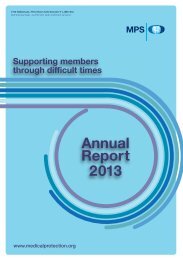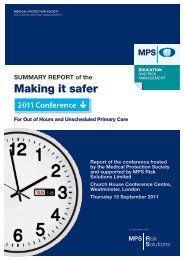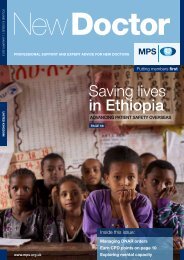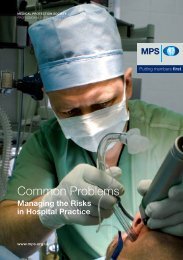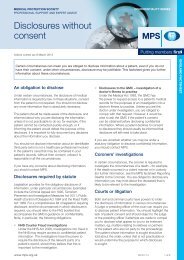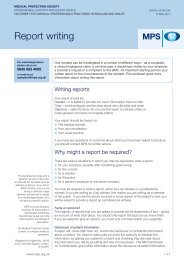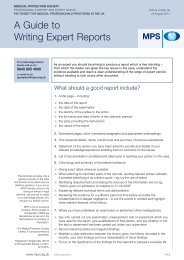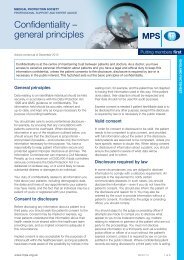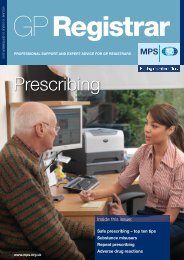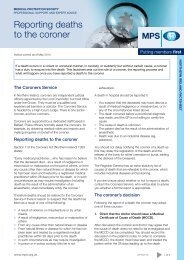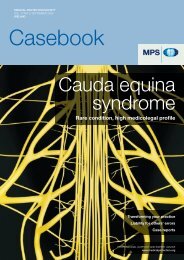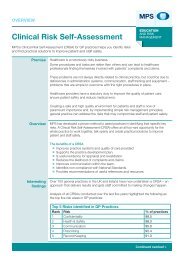New Doctor - Medical Protection Society
New Doctor - Medical Protection Society
New Doctor - Medical Protection Society
Create successful ePaper yourself
Turn your PDF publications into a flip-book with our unique Google optimized e-Paper software.
and treatment, but also<br />
balancing the consequences<br />
for the other passengers if<br />
the plane had to be diverted.<br />
What would be the legal<br />
implications had I made a<br />
mistake with my judgment?<br />
I had to make a clinical<br />
decision about the diagnosis<br />
and decided against<br />
diverting the plane, at least<br />
until we had made contact<br />
with ground support.<br />
When Moscow was in<br />
proximity, the crew informed<br />
me that the pilot wanted to<br />
know again about whether<br />
the plane should be landed.<br />
At this point, the patient’s<br />
chest pain had eventually<br />
settled and I felt more<br />
confident about my decision<br />
not to land the plane. Shortly<br />
following this the cabin crew<br />
gained contact with ground<br />
staff who agreed with our<br />
management plan.<br />
We decided to document<br />
everything we had done<br />
in case there were any<br />
questions about our<br />
management plan. The<br />
last two to three hours<br />
of the journey seemed<br />
to last forever before<br />
we finally landed at our<br />
destination. Much to my relief,<br />
paramedics were waiting to<br />
take the patient to hospital.<br />
The cabin crew and patient<br />
were very grateful for my help<br />
and it turned out to be a great<br />
learning experience for me.<br />
Dr Lau is currently<br />
an F2 working at<br />
Stepping Hill Hospital<br />
in Stockport.<br />
Book<br />
review<br />
Doing Clinical Ethics:<br />
A Hands-on Guide for<br />
Clinicians and Others –<br />
by Daniel Sokol, barrister<br />
and senior lecturer<br />
in medical ethics at<br />
Imperial College London<br />
(Springer 2012)<br />
Reviewed by Dr June Tay, junior<br />
doctor in anaesthetics, London<br />
Doing Clinical Ethics is a concise and<br />
comprehensive book, which is easy<br />
to read. The author, Daniel Sokol,<br />
beautifully captures the theoretical essence<br />
of medical ethics and applies it to real<br />
life. He divides his book into five chapters,<br />
encompassing ethical theory and casebased<br />
discussions, teaching, writing papers<br />
and research in the ethical context.<br />
Chapter 1 provides a step-by-step<br />
guide to approaching a clinical scenario.<br />
Sokol summarises the sections into moral<br />
perception, moral reasoning and moral<br />
action. Within moral reasoning, he outlines<br />
the four principles: respect for autonomy,<br />
beneficence, non-maleficence and justice.<br />
He also introduces the “four quadrants<br />
approach”, which can be applied to every<br />
clinical case. These are medical indications,<br />
patient preferences, quality of life and<br />
contextual features. An example provided<br />
was the case of a 22-year-old woman, BMI<br />
51, with a history of self harm, who set<br />
herself alight moments after discharge from<br />
the emergency department, and as a result<br />
had to be admitted to intensive care and a<br />
specialist burns unit. Tattooed on her chest<br />
was the following: DNAR (underlined) DO<br />
NOT RESUSCITATE. He clearly analyses<br />
the ethical issues employing the “four<br />
quadrants approach”, which makes for<br />
really interesting reading.<br />
What I gained the most from the book is<br />
encompassed in the next chapter, which<br />
covers writing and publishing a paper.<br />
Sokol draws most of the examples on<br />
writing an ethics paper; however, these<br />
are universally applicable to other topics<br />
and articles. The elements addressed and<br />
the examples given resonate well with the<br />
challenges faced by clinicians – authorship,<br />
rejections and abstract submissions.<br />
Most of this insightful advice is not<br />
obtainable from textbooks, but only<br />
discovered through an individual’s experiences<br />
and struggles. Nevertheless, these issues are<br />
applicable to a junior doctor’s clinical career.<br />
Not to be missed is the chapter on<br />
delivering teaching. Sokol elaborates on the<br />
various aspects of teaching junior doctors,<br />
medical students and other clinicians, with<br />
particular attention to teaching ethics.<br />
However, it is advice that one could employ<br />
to improve their teaching skills in general.<br />
Perhaps this chapter would benefit from<br />
further elaboration in a book on teaching skills.<br />
The final chapter consists of appendices<br />
using pertinent examples of ethical issues<br />
that clinicians may encounter. Sokol provides<br />
a few cases and discusses the ethical<br />
principles involved. Among the two that I<br />
found most pertinent to my role as a junior<br />
doctor are “The Slipperiness of Futility” and<br />
“The Dilemma of Authorship”. It is perhaps<br />
the most engaging chapter in the book as<br />
real-life examples are employed, which most<br />
clinicians can identify closely with.<br />
Overall, Doing Clinical Ethics is concise<br />
and uses simple language devoid of jargon.<br />
It particularly appeals to one who does<br />
not have the patience to dwell on lengthy<br />
prose. Perhaps some may feel that there<br />
is a lack of philosophical discussion of<br />
moral dilemmas, such as euthanasia and<br />
physician-assisted suicide. Others may feel<br />
that the aspects on teaching and writing<br />
ethics are too general and not particularly<br />
suited for a book entitled Doing Clinical<br />
Ethics. Nevertheless, it is a good read for<br />
anyone interested in medical ethics.<br />
If you would like to review a book, website, film or app email sara.williams@mps.org.uk<br />
15<br />
BOOK REVIEW<br />
NEW DOCTOR | VOLUME 5 | ISSUE 2 | 2012 | UNITED KINGDOM www.mps.org.uk



